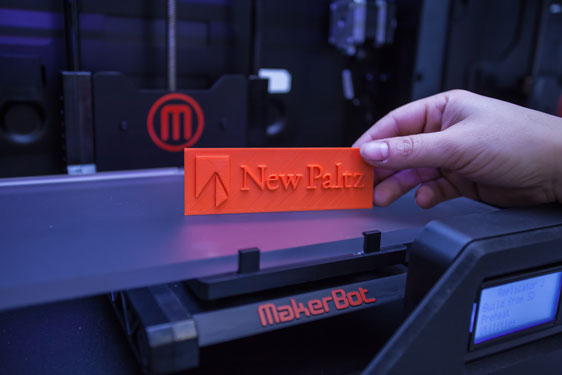New classes introduce 3D design and printing to campus community
 The Hudson Valley Advanced Manufacturing Center (HVAMC) at SUNY New Paltz is offering two 75-minute classes, “Intro to 3D Printing” and “Intro to Modeling for FDM Printing,” for faculty, staff and students with little or no experience in 3D design and printing. These classes will soon be available to members of the community.
The Hudson Valley Advanced Manufacturing Center (HVAMC) at SUNY New Paltz is offering two 75-minute classes, “Intro to 3D Printing” and “Intro to Modeling for FDM Printing,” for faculty, staff and students with little or no experience in 3D design and printing. These classes will soon be available to members of the community.
“A major goal of our 3D printing initiatives is to open up this technology to everyone on campus, because we see 3D printing as a universal tool that will eventually become as common as a personal computer,” said Dan Freedman, dean of the School of Science and Engineering and director of the HVAMC.
Classes will be taught by Aaron Nelson, MakerBot Innovation Center (MIC) instructional support technician, who expects them to appeal to people working not only in science and engineering but across disciplines as diverse as fine arts, history, natural and social sciences and business.
“We’re seeing that a lot of people want to use this equipment, but they don’t really know how to get in on the ground level,” Nelson said. “The whole idea of this lab is to democratize access to this equipment for the whole campus community, but one element that’s missing is the knowledge to use it. We hope these courses serve as a kind of bridge: the equipment is here, the expertise is here, now we just need to give this to everybody.”
The first class, “Intro to 3D Printing,” gives an overview of various 3D printers and print processes. It also discusses the MIC and its role in serving the College, including by offering ready-modeled designs that can be accessed and used by anyone.
“Intro to Modeling for FDM Printing” advances to offer instruction in TinkerCAD, a free, accessible, user-friendly tool for designing 3D models using a web browser. The course will offer basic guidance in combining “primitives,” the simple shapes that are the fundamental building blocks of 3D design, into complex objects that can then be output to the MakerBot printers.
Most importantly, the two classes are intended to expand access to a truly disruptive new technology that is not yet widely available to the public. “This campus is very special in that we have resources, people and equipment that many places don’t have,” Nelson said. “So this is a great opportunity for people who are attached to this place to come and gain some knowledge that they can’t get just about anywhere else.”
Nelson’s advice to newcomers is to be excited by 3D printing, rather than intimidated. “This can be a little overwhelming, and there’s a lot of terminology that gets tossed around, but in the end it’s really just assembling simple things into complex things,” he said. “Just approach it like any other learning exercise: start with the most basic, simple stuff, and don’t be afraid to fail.”
To register for the classes, visit http://www.newpaltz.edu/3d/classes.html.
About New Paltz’s 3D Printing Initiative
Since launching the HVAMC in spring 2013, the College’s effort to fuse learning and manufacturing, science and the arts has continued to gain momentum. In February 2014, the College partnered with Brooklyn, N.Y. – based MakerBot, the leading manufacturer of desktop 3D printers, to open the nation’s first MakerBot Innovation Center at SUNY New Paltz. The 3D Printing Initiative received additional funding in fall 2014, including a $10 million NYSUNY 2020 Challenge Grant to help establish an Engineering Innovation Hub and $850,000 in capital funding for a new 3D printing laboratory. In December 2013, the Mid-Hudson Regional Economic Development Council and Governor Andrew Cuomo awarded the College $1M in state economic development funds. Currently, the HVAMC is providing digital design and fabrication expertise to about 60 businesses and entrepreneurs throughout the region. The Center also engages the local community and educates the public about the possibilities of 3D printing. Workshops and courses for K-12 educators, including through the Governor’s New York State Master Teachers Program, have attracted a wide variety of teachers, from art to science, who have an interest in digital design and fabrication and are utilizing these new technologies in their classrooms.
